10 Iconic Kyoto Landmarks for the Perfect Photo Op
As you plan your journey through Kyoto, consider these 10 iconic landmarks that are not just steeped in history but are also perfect for those memorable photo ops. From the shimmering reflection of Kinkaku-ji, the Golden Pavilion, to the endless vermilion torii gates at Fushimi Inari Taisha Shrine, each site offers a unique backdrop that captures the essence of this ancient city. While you've likely heard of some, like the tranquil Arashiyama Bamboo Grove, others might surprise you with their hidden beauty and cultural significance. Stay tuned as we explore why each of these sites deserves a spot on your itinerary and in your photo gallery.
Kinkaku-ji: The Golden Pavilion
Kinkaku-ji, also known as the Golden Pavilion, dazzles visitors with its shimmering gold-leaf facade set against a tranquil pond. When you first glimpse the structure, its reflection in the water doubles the impact, making it seem as though you're looking at a mirage. This iconic temple, originally the retirement villa of shogun Ashikaga Yoshimitsu, was transformed into a Zen Buddhist temple after his death in 1408.
As you wander the carefully landscaped grounds, you'll notice the pavilion is brilliantly designed to highlight the contrast between its bold golden hue and the surrounding greenery. Depending on the season, the backdrop ranges from lush green summers to fiery red autumns, each providing a unique frame for your photos. Don't rush your visit; take your time to appreciate the different angles and reflections from various spots around the pond.
The upper floors, which you can't access, are coated in gold leaf and capped with a shining phoenix, symbolizing rebirth and immortality. This detail reinforces the pavilion's ethereal appearance and underscores its historical significance. Remember, while you can't enter the pavilion, the view from the outside offers a breathtaking spectacle that encapsulates the essence of Kyoto's traditional aesthetics.
Fushimi Inari Taisha Shrine
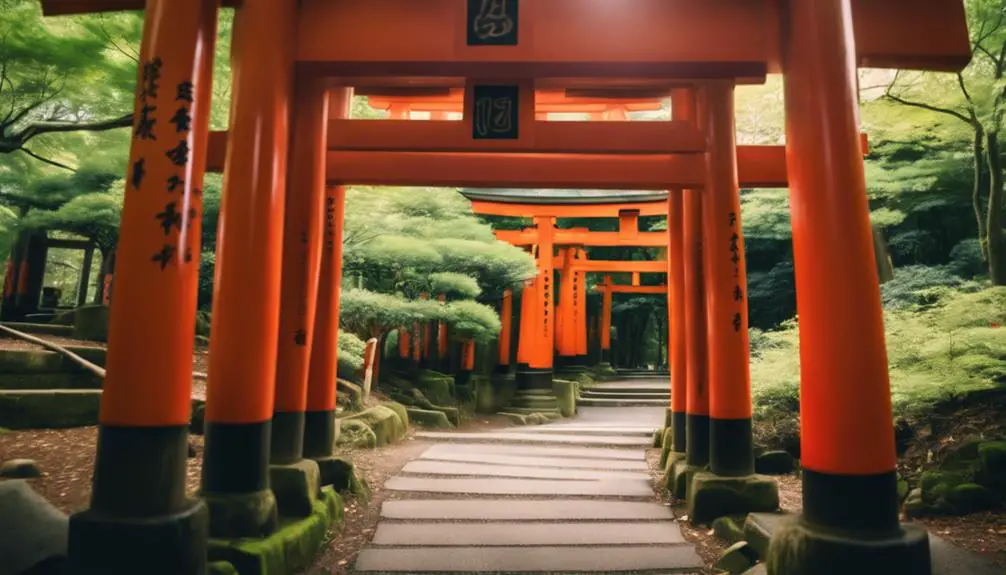
Now, let's explore another gem of Kyoto, the Fushimi Inari Taisha Shrine, renowned for its thousands of vibrant red torii gates. This shrine, dedicated to Inari, the Shinto god of rice, has been a spiritual center since the 8th century. You'll find it nestled at the base of a mountain also named Inari, which is just a short train ride from Kyoto Station.
Here are three must-see features at Fushimi Inari Taisha Shrine:
- Senbon Torii (Thousands of Torii Gates)
As you walk through the seemingly endless arcades of sacred torii gates, you're literally stepping through one of Japan's most iconic scenes. These gates, donated by individuals and businesses hoping for prosperity, create a mesmerizing, vermillion tunnel that winds up the mountain.
- Romon Gate
At the shrine's entrance stands the impressive Romon Gate, donated by a famous samurai in the 16th century. It's an ideal spot for a striking photo with its intricate woodwork and towering presence.
- Okusha Hohaisho Prayer Spot
At the top, reward yourself with a visit to the Okusha Hohaisho prayer spot. Here, you can enjoy panoramic views of Kyoto while soaking in the spiritual atmosphere.
Take your time to explore and appreciate the tranquility and beauty of this sacred site.
Arashiyama Bamboo Grove
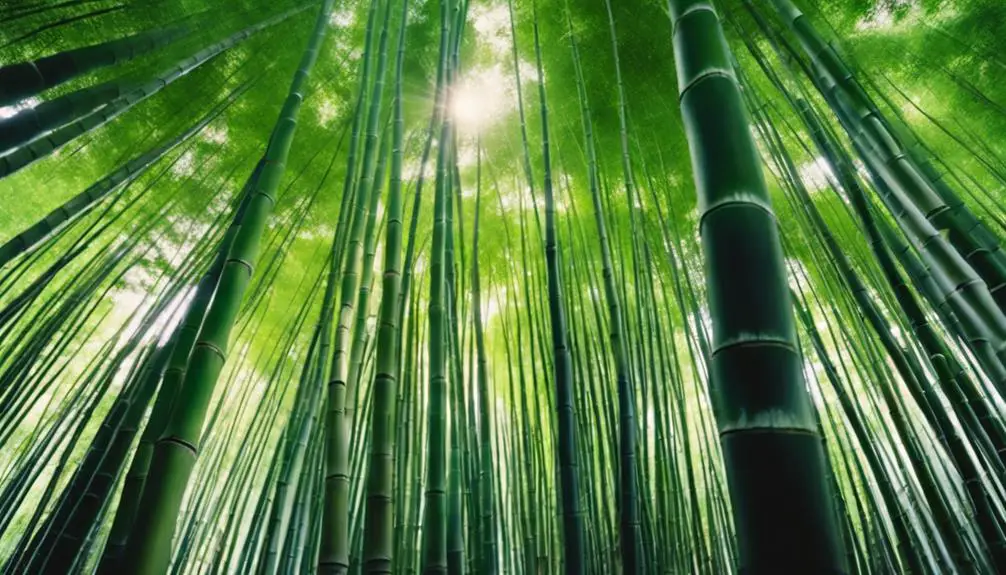
Step into the serene world of Arashiyama Bamboo Grove, where towering stalks sway gently in the breeze, creating a mesmerizing, natural tunnel that transports you to another domain. As you wander through this lush, verdant corridor, you're surrounded by shades of green that seem almost otherworldly in their intensity and beauty. The sun filters through the dense canopy above, casting a soft, dappled light on the path underfoot.
This grove isn't just a feast for the eyes; it's a sanctuary of sound. The rustle of the bamboo, the only noise breaking the silence, has a way of making you feel like you're the only person in the world. It's a place where you can escape the hustle and bustle of city life and find a moment of peace.
Bring your camera, because you'll want to capture the ethereal beauty of this place. Early morning is the best time to visit, when the light is just right and the crowds are thinner. Stand still, listen to the whisper of the leaves, and let the tranquility of Arashiyama Bamboo Grove envelop you.
Don't rush your visit; every step reveals a new perspective, each more breathtaking than the last.
Ginkaku-ji: The Silver Pavilion
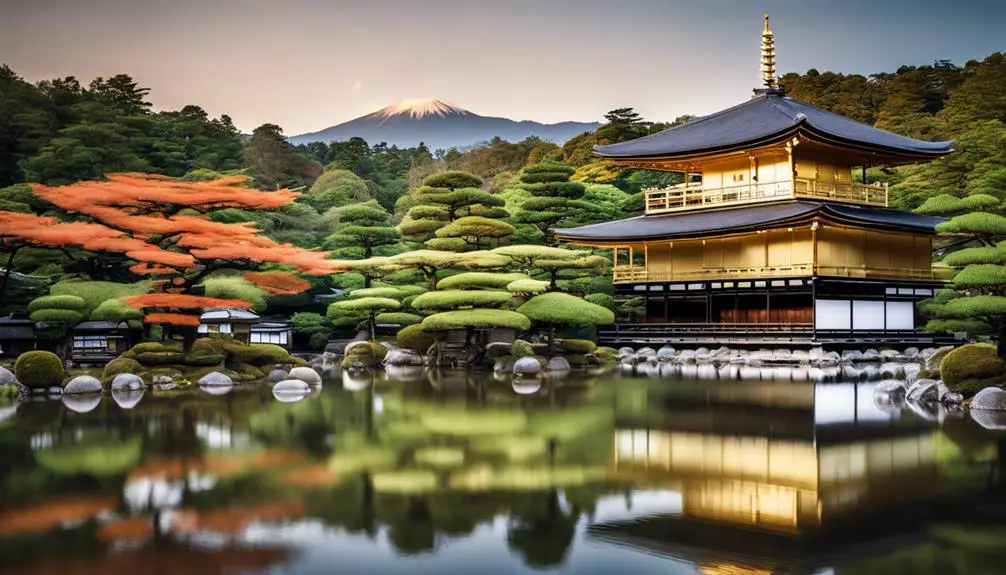
After exploring the natural beauty of Arashiyama Bamboo Grove, you'll find the architectural elegance of Ginkaku-ji, the Silver Pavilion, equally enchanting. Nestled in Kyoto's eastern mountains, Ginkaku-ji isn't actually silver-coated but derives its name from the moonlight reflecting off its dark exterior. This Zen temple, originally a shogun's villa, represents the Higashiyama culture of the Muromachi period, emphasizing simplicity and tranquility.
Here's why you can't miss it:
- The Path of Philosophy: Start your visit with a stroll down the famous Philosopher's Path leading to the temple. It's especially stunning in cherry blossom season when the path is lined with blooms.
- The Gardens: Ginkaku-ji is surrounded by meticulously maintained sand gardens, including the iconic Silver Sand Sea and a perfectly shaped cone known as the Moon Viewing Platform. These gardens reflect the Japanese aesthetic of wabi-sabi, finding beauty in imperfection.
- The Pavilion Itself: Although it's less flashy than its golden counterpart Kinkaku-ji, the Silver Pavilion offers a subtle, refined beauty. Its two-story structure features a unique combination of shoin-zukuri and buke-zukuri architectural styles, which you can admire up close.
Make sure to bring your camera; the serene elegance of Ginkaku-ji makes it a photographer's dream.
Nijo Castle
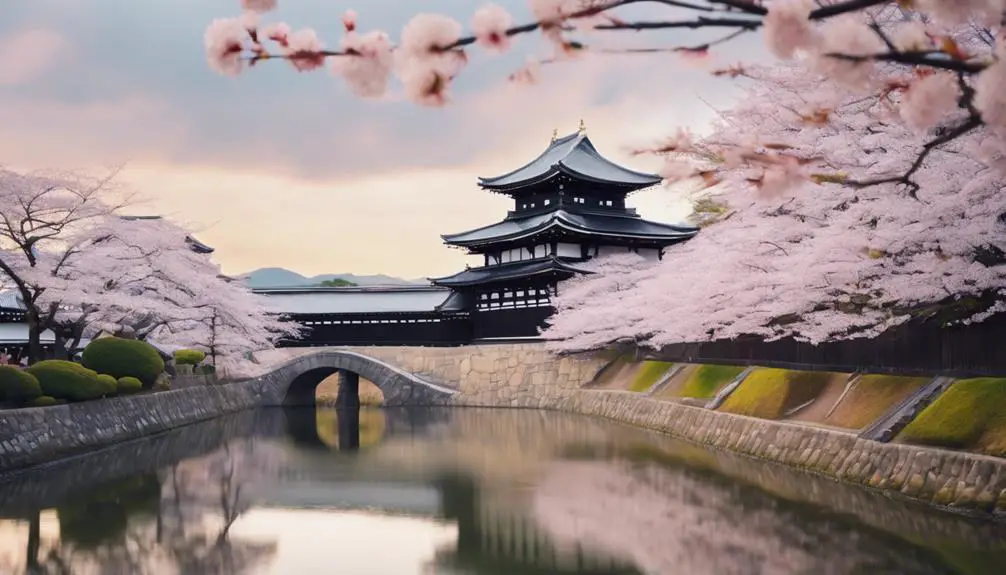
Continuing your journey through Kyoto's historical wonders, you'll encounter Nijo Castle, a breathtaking tribute to Japan's feudal era. Built in 1603 as the Kyoto residence of Tokugawa Ieyasu, the first shogun of the Edo Period, this castle showcases the power and prestige that the shoguns wielded.
As you stroll through the massive gates, you're stepping back in time. The castle's architecture is a marvel, with ornate carvings and expansive, well-preserved grounds. Don't miss the Ninomaru Palace, famous for its 'nightingale floors' designed to chirp when walked upon, alerting occupants to any intruders. The rooms are adorned with beautifully painted sliding doors and screens, crafted by artists of the Kano school, depicting scenes of nature and landscapes that evoke a bygone era.
Outside, the gardens are equally impressive. They're an ideal spot for reflection and photography, especially during cherry blossom season when the beauty is almost surreal. The contrast of stone fortifications with delicate pink blossoms creates a scene you'll want to capture.
Nijo Castle isn't just a stop on a tourist's itinerary; it's a profound glimpse into the art and history of Japan. You'll leave with a deeper appreciation for the craftsmanship and strategic complexity of feudal Japan.
Kyoto Imperial Palace
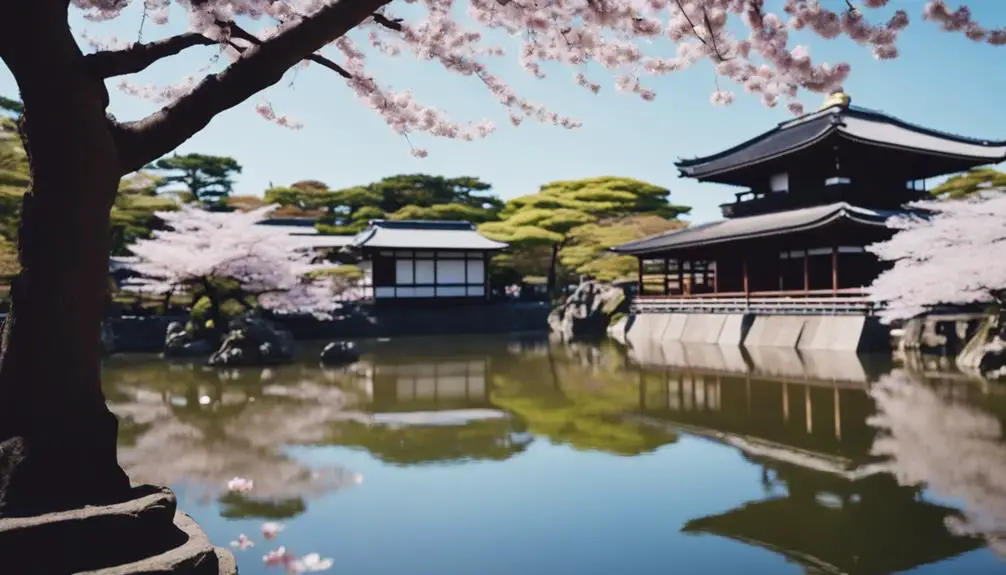
If you're captivated by the regal history of Nijo Castle, the Kyoto Imperial Palace will further enchant you with its imperial elegance and historical significance. Nestled in the expansive Kyoto Imperial Park, this palace served as the residence of Japan's Imperial Family until the capital moved to Tokyo in 1869. Today, it stands as a tribute to the cultural heritage and architectural grandeur of Japan.
Here are three key highlights you shouldn't miss:
- The Kogosho: Once a venue for important ceremonies, the Kogosho charms with its simplistic yet elegant design. You'll appreciate the fusion of functionality and artistic craftsmanship.
- Garden Views: The palace is surrounded by classical Japanese gardens. Each season brings a new splash of color and texture, making any visit a fresh experience. The serene ponds and meticulously maintained plants create a peaceful backdrop perfect for contemplation and photography.
- Imperial Ceremonies: Plan your visit during one of the public ceremonies or special openings. Witnessing an event like the Shinto rites, performed just as they've been for centuries, offers a rare glimpse into Japan's imperial traditions and the ongoing role of the palace in modern Japanese society.
Kiyomizu-dera Temple
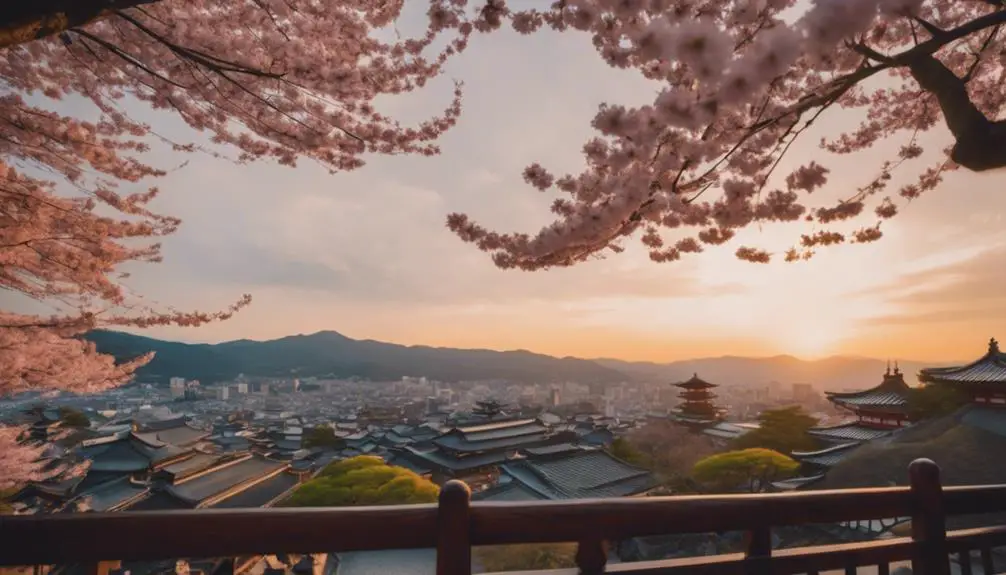
Stepping into the tranquil world of Kiyomizu-dera Temple, you'll discover a spiritual haven perched on the eastern hills of Kyoto. Founded in the late 8th century, this historic temple offers not just a profound sense of peace but also spectacular views of the city below.
As you wander through its expansive grounds, you'll be struck by the stunning architecture and the vibrant vermillion halls that contrast beautifully against the surrounding greenery.
Don't miss the famous wooden stage of the main hall, which juts out over the hillside. Here, you're afforded a panoramic view that's particularly breathtaking during cherry blossom season or when autumn colors set the landscape ablaze. It's said that jumping from this platform and surviving meant your wish would be granted, though it's strongly discouraged today!
Make sure you also explore the Jishu Shrine, dedicated to Ōkuninushi, a deity of love and matchmaking. Here, you can test your romantic destiny by walking blindfolded between two stones placed several meters apart. Successfully reaching the other stone is supposed to signify finding true love.
Kiyomizu-dera isn't just a photo opportunity; it's a place where you can truly connect with Japan's rich cultural and spiritual tapestry.
Philosopher's Path
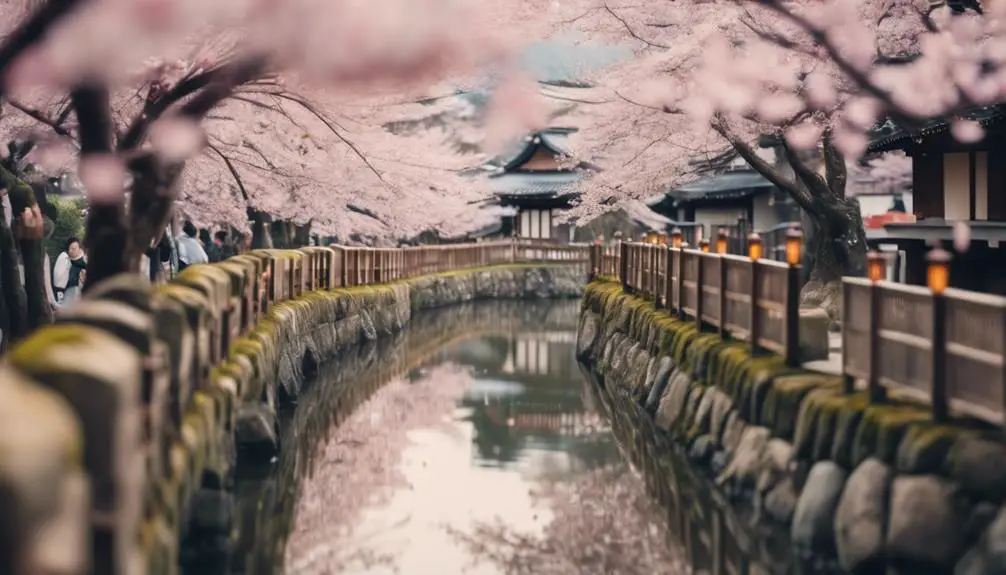
From Kiyomizu-dera, a short journey leads you to the serene Philosopher's Path, another must-visit Kyoto landmark. Named after the famous Japanese philosopher Nishida Kitaro, who's said to have used this path for his daily meditative walks, it offers a unique blend of natural beauty and historical significance.
This stone path follows a canal lined with hundreds of cherry trees, making it especially breathtaking during sakura season when the blossoms are in full bloom.
Here are three reasons why you shouldn't miss the Philosopher's Path:
- Seasonal Beauty: No matter the season, the path offers stunning views. Spring brings cherry blossoms, summer is lush and verdant, fall showcases fiery maple leaves, and winter often features a delicate dusting of snow.
- Cafes and Shops: Along the path, you'll find quaint cafes and small shops. It's perfect for enjoying a quiet moment with a cup of matcha or picking up unique, locally-made souvenirs.
- Historical Temples: Several significant temples line the path, including Honen-in and Anrakuji. Each offers a glimpse into Kyoto's rich cultural tapestry and provides peaceful spots for reflection.
Taking a stroll here isn't just a walk; it's a journey through the heart of Kyoto's history and beauty.
Heian Shrine
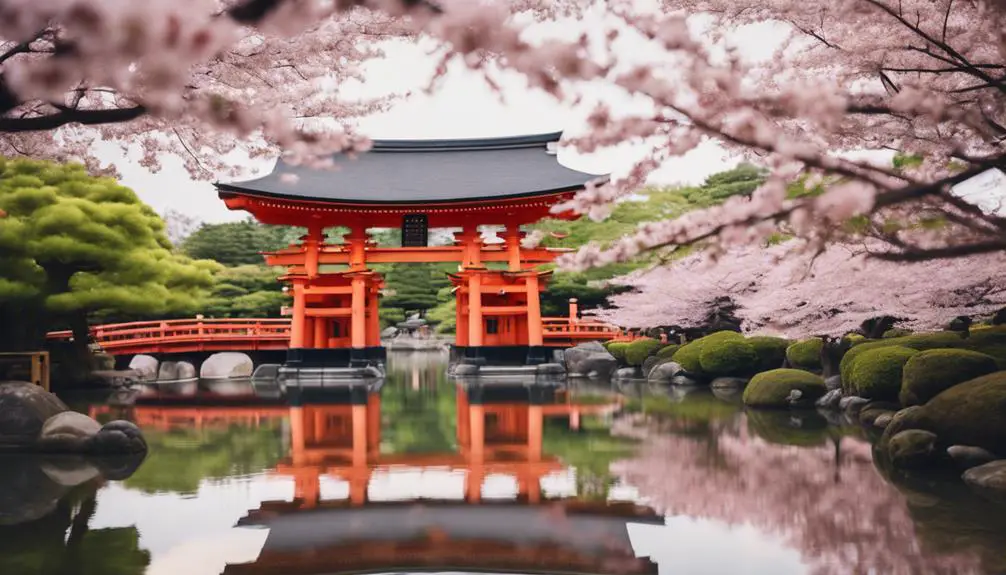
Continuing your exploration of Kyoto, you'll find the majestic Heian Shrine, an essential visit for anyone interested in the city's cultural heritage. This shrine, established in 1895, celebrates the 1100th anniversary of Kyoto becoming Japan's capital. As you step through its massive torii gate, one of the largest in Japan, you'll feel like you're entering another era.
The architecture of Heian Shrine is a partial replica of the original Imperial Palace from the Heian Period, showcasing a blend of Shinto and Chinese influences. The shrine's bright vermilion and green accents stand out against the serene gardens surrounding it.
Don't miss the chance to wander through these expansive gardens, split into four distinct parts. Each section offers a different seasonal beauty, from cherry blossoms in spring to irises in early summer.
Photography enthusiasts will love capturing the striking contrast between the vivid shrine structures and the tranquil water features. The large pond, with its quaint bridges and stepping stones, makes for particularly stunning photo opportunities.
Whether you're soaking up history, admiring the artistry, or just enjoying a peaceful break, Heian Shrine offers a rich, picturesque slice of Kyoto's past and present.
Yasaka Pagoda
Nestled in the heart of Kyoto's historic Higashiyama district, Yasaka Pagoda stands as a striking demonstration of ancient craftsmanship and religious heritage. As you explore its five towering stories, you're not just seeing a building; you're stepping into a piece of history that dates back to the 6th century.
The pagoda is part of Hokan-ji Temple, though it's commonly known by its nickname due to its proximity to Yasaka Shrine.
Here's why you should visit Yasaka Pagoda:
- Photographic Charm: Its unique architecture makes it a favorite among photographers. The wooden structure against the backdrop of cherry blossoms or autumn leaves creates a perfect harmony of color and form.
- Panoramic Views: Climb to the top and you'll be rewarded with breathtaking views over Kyoto. It's an ideal spot for sunset or early morning photos when the city is bathed in soft light.
- Cultural Immersion: Surrounding streets, like Ishibei-koji and Ninenzaka, offer a glimpse into old Kyoto. You'll find traditional tea houses and artisan shops, enhancing your experience and understanding of Kyoto's rich culture.
